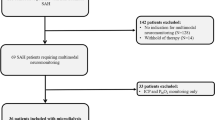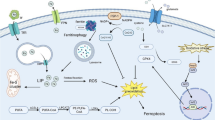Abstract
Introduction
Iron-mediated oxidative damage has been implicated in the genesis of cerebral vasospasm in animal models of SAH. We sought to explore the relationship between levels of non-protein bound iron in cerebrospinal fluid and the development of brain injury in patients with aneurysmal SAH.
Methods
Patients admitted with aneurysmal subarachnoid hemorrhage to a Neurointensive care unit of an academic, tertiary medical center, with Hunt and Hess grades 2–4 requiring ventriculostomy insertion as part of their clinical management were included in this pilot study. Samples of cerebrospinal fluid (CSF) were obtained on days 1, 3, and 5. A fluorometric assay that relies on an oxidation sensitive probe was used to measure unbound iron, and levels of iron-handling proteins were measured by means of enzyme-linked immunosorbent assays. We prospectively collected and recorded demographic, clinical, and radiological data.
Results
A total of 12 patients were included in this analysis. Median Hunt and Hess score on admission was 3.5 (IQR: 1) and median modified Fisher scale score was 4 (IQR: 1). Seven of 12 patients (58 %) developed delayed cerebral ischemia (DCI). Day 5 non-transferrin bound iron (NTBI) (7.88 ± 1 vs. 3.58 ± 0.8, p = 0.02) and mean NTBI (7.39 ± 0.4 vs. 3.34 + 0.4 p = 0.03) were significantly higher in patients who developed DCI. Mean redox-active iron, as well as day 3 levels of redox-active iron correlated with development of angiographic vasospasm in logistic regression analysis (p = 0.02); while mean redox-active iron and lower levels of ceruloplasmin on days 3, 5, and peak concentration were correlated with development of deep cerebral infarcts.
Conclusions
Our preliminary data indicate a causal relationship between unbound iron and brain injury following SAH and suggest a possible protective role for ceruloplasmin in this setting, particularly in the prevention of cerebral ischemia. Further studies are needed to validate these findings and to probe their clinical significance.


Similar content being viewed by others
Explore related subjects
Discover the latest articles and news from researchers in related subjects, suggested using machine learning.References
Xi G, Keep RF, Nakamura T, et al. Mechanisms of brain injury after intracerebral hemorrhage. Lancet Neurol. 2006;5:53–63.
Selim M, Yeatts S, Goldstein JN, Gomes J, et al. Safety and tolerability of deferoxamine mesylate in patients with acute intracerebral hemorrhage. Stroke. 2011;42:3067–74.
Yeatts SD, Palesch YY, Moy CS, Selim M. High dose deferoxamine in intracerebral hemorrhage (HI-DEF) trial: rationale, designs, and methods. Neurocrit Care. 2013;19:257–66.
Lee J-Y, Sagher O, Keep R, et al. Comparison of experimental rat models of early brain injury after subarachnoid hemorrhage. Neurosurgery. 2009;65:331–43.
Savman K, Nilsson UA, Blennow M, et al. Non-protein-bound iron is elevated in cerebrospinal fluid from preterm infants with posthemorrhagic ventricular dilatation. Pediatr Res. 2001;49:208–12.
Nilsson UA, Bassen M. Savman, et al. A simple and rapid method for determination of “free” iron in biological fluids. Free Radical Res. 2002;36:677–84.
Bishop GM, Robinson SR. Quantitative analysis of cell death and ferritin expression in response to cortical iron: implications for hypoxia-ischemia and stroke. Brain Res. 2001;907:175–87.
Mori T, Nagata K, Town T, et al. Intracisternal increase of superoxide anion production in a canine subarachnoid hemorrhage model. Stroke. 2001;32:636–42.
Cabantchik ZI, Breuer W. LPI-Labile plasma in iron overload. Best Practice & Research in Clinical Haematology. 2005;18:277–87.
Diringer MN, Bleck TP, Hemphill JC III, et al. Critical care management of patients following aneurysmal subarachnoid hemorrhage: recommendations from the neurocritical care society’s multidisciplinary consensus conference. Neurocrit Care. 2011;15:211–40.
Connolly ES, Rabinstein AA, Carhuapoma JR, et al. Guidelines for the management of aneurysmal subarachnoid hemorrhage: a guideline for healthcare professionals from the American Heart Association/American Stroke Association. Stroke 2012 (published online May 3, 2012).
Vergouwen MDI. – The participants in the International multi-disciplinary consensus conference on the critical care management of subarachnoid hemorrhage. Vasospasm versus delayed cerebral ischemia as an outcome event in clinical trials and observational studies. Neurocrit Care. 2011;15:308–11.
Rabinstein AA, Weigend S, Atkinson JL, Wijdicks EF. Patterns of cerebral infarction in aneurysmal subarachnoid hemorrhage. Stroke. 2005;36:992–7.
Teunissen CE, Petzold A, Bennett JL, et al. A consensus protocol for the standardization of cerebrospinal fluid collection and biobanking. Neurology. 2009;73:1914–22.
Breuer W, Ghoti H, Shattat A, et al. Non-transferrin bound iron in Thalassemia: differential detection of redox active forms in children and older patients. Am J Hematol. 2012;87:55–61.
Lee JY, Keep RF, Hua Y et al: The role of iron in brain following subarachnoid hemorrhage. In, Li YV and Zhang JH (Eds): Metal Ion in Stroke. Springer New York 2012.
Macdonald RL, Weir BKA. A review of hemoglobin and the pathogenesis of cerebral vasospasm. Stroke. 1991;22:971–82.
Turner CP, Bergeron M, Matz P, et al. Heme-oxygenase-1 (HO-1) is induced in glia throughout the brain by subarachnoid hemoglobin. J Cereb Blood Flow Metab. 1998;18:257–73.
Carbonell T, Rama R. Iron, oxidative stress and early neurological deterioration in ischemic stroke. Curr Med Chem. 2007;14:857–74.
Asano T, Tanishima T, Sasaki T, et al. Possible participation of free radical reactions initiated by clot lysis in the pathogenesis of vasospasm after subarachnoid hemorrhage. In: Wilkins RH, editor. Cerebral arterial spasm. Baltimore, MD: Williams & Wilkins; 1980.
Pyne-Geithman GJ, Nair S, Caudell Stamper DN, et al. Role of bilirubin oxidation products in the pathophysiology of DIND following SAH. In: Zuccarello et al (Eds): Cerebral vasospasm: Neurovascular events after subarachnoid hemorrhage. Acta Neurochir Suppl. 2013;115:267–73.
Lochhead JL, McCaffrey G, Quigley CE, et al. Oxidative stress increases blood-brain barrier permeability and induces alterations in occluding during hypoxia-reoxygenation. J Cereb Blood Flow Metab. 2010;30:1625–36.
Lee JY, Keep RF, He Y, et al. Hemoglobin and iron handling in brain after subarachnoid hemorrhage and the effect of deferoxamine on early brain injury. J Cereb Blood Flow and Metab. 2010;30:1793–803.
Kaur D, Rajagopalan S, Chinat S, et al. Chronic ferritin expression within murine dopaminergic midbrain neurons result in a progressive age-related neurodegeneration. Brain Res. 2007;1140:188–94.
Vollmer DG, Hongo K, Ogawa H, et al. A study of the effectiveness of the iron-chelating agent deferoxamine as vasospasm prophylaxis in a rabbit model of subarachnoid hemorrhage. Neurosurgery. 1991;28:27–32.
Horky LL, Pluta RM, Boock RJ, Oldfield EH. Role of ferrous iron chelator 2,2’-dipyridyl in preventing delayed vasospasm in a primate model of subarachnoid hemorrhage. J Neurosurg. 1998;88:298–303.
Suzuki H, Muramatsu M, Kojima T, Taki W. Intracranial heme metabolism and cerebral vasospasm after aneurysmal subarachnoid hemorrhage. Stroke. 2003;34:2796–800.
Nakashima T, Takenaka K, Fukazawa S, et al. Purification of a factor from CSF in patient after SAH which induces the cytosolic free calcium elevation in vascular smooth muscle cells. Neurol Res. 1997;19:51–6.
Takenaka KV, Sakai N, Murase S, et al. Elevated transferrin concentration in cerebral spinal fluid after subarachnoid hemorrhage. Neurol Res. 2000;22:797–801.
Hellman NE, Gitlin JD. Ceruloplasmin metabolism and function. Annu Rev Nutr. 2002;22:439–58.
Osaki S, Johnson D, Frieden E. The possible significance of the ferrous oxidase activity of ceruloplasmin in normal human serum. J Biol Chem. 1966;241:2746–57.
Gutteridge JM. Antioxidant properties of ceruloplasmin towards iron- and copper-dependent oxygen radical formation. FEBS Lett. 1983;157:37–40.
Chapman ALP, Mocatta TJ, Shiva S, et al. Ceruloplasmin is an endogenous inhibitor of myeloperoxidase. J Biol Chem. 2013;288:6465–77.
Bakhautdin B, Febbraio M, Goksoy E, et al. Protective role of macrophage-derived ceruloplasmin in inflammatory bowel disease. Gut. 2013;62:209–19.
Harris ZL, Klomp LWJ, Gitlin JD. Aceruloplasminemia: an inherited neurodegenerative disease with impairment of iron homeostasis. Am J Nutr. 1998;67(suppl):972S–7S.
Patel BN, Dunn RJ, Jeong SY, et al. Ceruloplasmin regulates iron levels in the CNS and prevents free radical injury. J Neurosci. 2002;22:6578–86.
Naidech AM, Bendock BR, Bassin SL, et al. Classification of cerebral infarction after subarachnoid hemorrhage impacts outcome. Neurosurgery. 2009;64:1052–8.
Benarroch EE. Brain iron homeostasis and neurodegenerative disease. Neurology. 2009;72:1436–40.
Marrif HI, Alwabel NA, Mousa HM. Brain lactoferrin: an endogenous peptide or merely an intruder. Am J Sci. Res. 2009;6:79–85.
Terent A, Hällgren R, Venge P, Bergström K. Lactoferrin, lysozyme, and beta 2- microglobulin in cerebrospinal fluid. Elevated levels in patients with acute cerebrovascular lesions as indices of inflammation. Stroke. 1981;12:40–6.
Hirsch EC, Faucheux BA. Iron metabolism and Parkinson’s disease. Mov Disord. 1998;13(Suppl 1):39–45.
Frazer DM, Anderson GJ. Hepcidin compared to prohepcidin: an absorbing story. Am J Clin Nutr. 2009;89:475–6.
Wang SM, Fu LJ, Duan XL, et al. Role of hepcidin in murine brain iron metabolism. Cell Mol Life Sci. 2010;67:123–33.
Lavados M, Guillon M, Mujica MC, et al. Mild cognitive impairment and Alzheimer patients display different levels of redox-active CSF iron. J Alzheimer Dis. 2008;13:225–32.
Acknowledgments
The authors wish to thank Prof. Loav Cabantchik (Hebrew University of Jerusalem, Israel) for his guidance with the NTBI and REDOX-Fe tests. The authors wish to acknowledge the assistance provided with statistical analysis by Esteban Walker, PhD (Department of quantitative health sciences, Cleveland Clinic. Cleveland, OH), and Dr. Jennifer Frontera for her help with selection of statistical software. We also wish to thank Valerie Swank for her assistance with sample processing. This study was supported by a grant from the Cerebrovascular Center, Cleveland Clinic. Cleveland, OH, USA.
Author information
Authors and Affiliations
Corresponding author
Rights and permissions
About this article
Cite this article
Gomes, J.A., Selim, M., Cotleur, A. et al. Brain Iron Metabolism and Brain Injury Following Subarachnoid Hemorrhage: iCeFISH-Pilot (CSF Iron in SAH). Neurocrit Care 21, 285–293 (2014). https://doi.org/10.1007/s12028-014-9977-8
Published:
Issue Date:
DOI: https://doi.org/10.1007/s12028-014-9977-8




